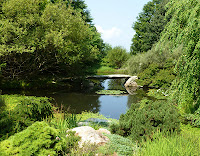Occasionally, the Principal Undergardener needs to get out
of the garden. But, even when he does,
horticulture is never far from his mind.
So it was yesterday, when Betty and I took a day trip to kayak the
Deerfield River in western Massachusetts.
 |
| The Principal Undergardener and the Master Gardener |
The Deerfield River is usually a broad, placid rock-strewn
stream coming down from the Berkshires.
Rising in southern Vermont, it parallels the very scenic Route 2 for
much of its 76-mile route toward the Connecticut River. Part of its tranquil nature is man-made: nine hydroelectric dams, some of them more
than a century old, dot the river.
Several times a week, one or more of these dams releases
excess water and, for a few hours, the Deerfield River bears a passable
resemblance to one of those wild western rivers where it’s Man Against
Nature. Several commercial outfits have
sprung up to take advantage of those man-made rapids. We went with CrabApple Whitewater, which offered us
a four-hour ‘self-guided’ tour in an inflatable kayak through eight miles of
river including Class I and II rapids.
It was supposed to be fun and it definitely was, but along
the way, I saw a reminder that when it’s Man Against Nature, nature is
invariably the winner.
 |
| This is Route 2 in Charlemont. Portions of the roadway were washed away |
A year ago this week, a weak, slow-moving storm named
Hurricane Irene plowed into New England.
It was barely a hurricane when it made landfall and was quickly
downgraded to a tropical storm and then a depression. The track of the storm was also considerably
west of the predicted track. Once expected
to hit Eastern Massachusetts, it missed Boston (I wrote about it here
and here) and,
for several hours, The Weather Channel wrote off the storm as a ‘near-miss’ and
its blue-jacketed reporters headed off for the next meteorological calamity.
 |
| The Bridge of Flowers in Shelburne Falls. See the video link below. |
What happened next was almost unthinkable. The great, soggy tropical mass headed up the
Connecticut River Valley and stalled for hours.
Western Massachusetts and southern Vermont received ten-plus inches of
rain - 100 trillion gallons (15 trillion cubic feet) in the Deerfield River
watershed alone. Already saturated from
much higher-than-normal rainfall in July and August, the rain from Irene flowed
down mountainsides and into valley and rivers.
The result was a catastrophe. On the weekend of August 27
and 28, rivers in southern Vermont and western Massachusetts (and, most
spectacularly, the Deerfield River) turned into monsters, creating the worst
flooding in recorded history in the region.
You can see video footage from the height of the flooding here.
Most of the subsequent news coverage focused on rebuilding
roads, but the damage to the river was also substantial. When the flood waters receded, farm fields
adjoining the river were buried under six inches of silt. Debris dams consisting of trees ripped out by
their roots and large boulders blocked the river at multiple points. Where there were no debris dams, there was ‘stream
reaming’ where fast-flowing water created a newly gouged riverbed that made the
river unusable for recreation.
 |
| The Deefield River on Monday. The trip was spectacular. |
A year later, there is still lingering damage evident, and navigating
the river came with some warnings. On
our eight-mile kayak journey down the Deerfield in Charlemont, we saw the
damage up close. Jen Mooney, who runs
CrabApple’s operations in Massachusetts, warned us before we set off of silt
deposits and tree debris that, even after a year’s work, made respecting the
river all the more important. “Keep to
the left at an island in the river channel; avoid silt and rock buildup just a
few inches below the water’s surface,” she told us. We saw areas where the riverbank was pocked with
small ravines and gullies.
 |
| Me on the river |
But the river’s restoration is also remarkable. In most areas, it is as though there was
never a storm. The restoration has been
a joint effort by the state and volunteer organizations. What they have accomplished is to be
commended.
We had a wonderful trip.
It was a reminder that our ‘near miss’ was western Massachusetts’ horror. A year ago, I wrote, “The next person who
calls Irene a dud will get nothing but a cold stare from me.”
Exactly.













